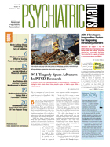None of us can help the things life has done to us. They're done before you realize it, and once they're done they make you do other things until at last everything comes between you and what you'd like to be, and you've lost your true self forever. —Eugene O'Neill, "Long Day's Journey Into Night"
National Institute on Drug Abuse (NIDA) Director Nora Volkow, M.D., addressed the audience in a voice close to tears. What they had just watched, she said, was "not an exaggeration. It is exactly what it is to live with addiction."
Volkow was referring to the reading of Act 3 of Eugene O'Neill's four-act Pulitzer prize-winning play, "Long Day's Journey Into Night," in which three-time Oscar nominee Debra Winger and her husband, Arliss Howard, had just portrayed the roles of spouses Mary and James Tyrone. Actors Bob Braswell and Sarah Waisanen read supporting roles.
The reading was part of the Addiction Performance Project, an educational theater performance presented by NIDAMED, the physicians' outreach initiative of NIDA. The Addiction Performance Project is a free continuing medical education program that gives health care providers "the opportunity to help break down the stigma associated with addiction and promote a healthy dialogue that fosters compassion, cooperation, and understanding for patients living with this disease."
Almost 300 attended the performance on the National Institutes of Health campus in Bethesda, Md., last month; another performance was scheduled for the following day at the Washington Convention Center, in conjunction with the American Psychological Association's annual meeting. The program was presented earlier this year in Phoenix, Boston, and Washington, D.C.
The Addiction Performance Project was developed and produced by Outside the Wire (<
www.outsidethewirellc.com>), a "social impact company" that uses theater and a variety of media to address pressing public health issues, such as combat-related psychological injury, end-of-life care, prison reform, and the destigmatization of the treatment of substance abuse and addiction.
Brian Doerries, artistic director of Outside the Wire, introduced the largely autobiographical play depicting the struggles of Mary Tyrone, a morphine-addicted mother and wife, and her husband and two adult sons, all three alcoholics.
He briefed the audience on the details of writer Eugene O'Neill's personal life, which closely mirrored the action in the play. He explored with the audience O'Neill's reaction to his writing, which was so powerful that O'Neill asked that the play be sealed until 25 years after his death (against his wishes, it was first performed only three years posthumously).
After the reading, Doerries facilitated a discussion with the audience and an expert panel composed of Volkow and Paul Christo, M.D., M.B.A., a pain-management specialist at Johns Hopkins. Referring to the character of Mary Tyrone, whose addiction began when she was treated with morphine after childbirth, Volkow pointed out that although the play was written in 1941 and set in 1911, "we have not changed much in the way we treat pain."
Christo spoke about his experiences as a practitioner: "Addiction has no boundaries. I can't guess who will develop the disease. It's a prospective process. The struggle is to confront rather than abandon our patients when addiction becomes apparent."


